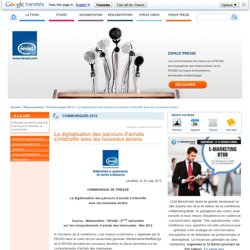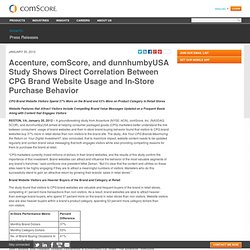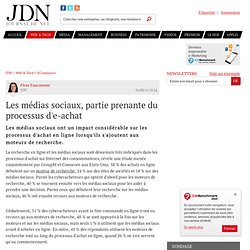

Www.fevad.com/uploads/files/Etudes/autres_etudes/prez_7Baro_comportements_achats_2011.pdf. La digitalisation des parcours d’achats s’intensifie avec les nouveaux écrans. Levallois, le 20 Juin 2012 La digitalisation des parcours d’achats s’intensifie avec les nouveaux écrans.

Www.accenture.com/SiteCollectionDocuments/PDF/Technology/Accenture-Are-Your-CPG-Brands-Maximizing-Return-Digital-Investment.pdf#zoom=50. Accenture, comScore, and dunnhumbyUSA Study Shows Direct Correlation Between CPG Brand Website Usage and In-Store Purchase Behavior. January 30, 2012 Accenture, comScore, and dunnhumbyUSA Study Shows Direct Correlation Between CPG Brand Website Usage and In-Store Purchase Behavior CPG Brand Website Visitors Spend 37% More on the Brand and 53% More on Product Category in Retail Stores Website Features that Attract Visitors Include Compelling Brand Value Messages Updated on a Frequent Basis Along with Content that Engages Visitors RESTON, VA, January 30, 2012 – A groundbreaking study from Accenture (NYSE: ACN), comScore, Inc.

(NASDAQ: SCOR), and dunnhumbyUSA aimed at helping consumer packaged goods (CPG) marketers better understand the link between consumers’ usage of brand websites and their in-store brand buying behavior found that visitors to CPG brand websites buy 37% more in retail stores than non-visitors to the brand site. “CPG marketers currently invest millions of dollars in their brand websites, and the results of this study confirm the importance of this investment. 1. 2. 3. Research Study Design. La complémentarité magasin/e-commerce mise en lumière par l’étude «Online Shopper Intelligence» de Kantar Media Compete. Pew: 25% of In-Store Shoppers Use Phones to Comparison Shop. Lisa Lacy | January 30, 2012 | 0 Comments inShare44 New study examines the mobile research habits of bricks-and-mortar shoppers.

More than half of consumers used their mobile devices during the holiday season to aid in purchase decisions while looking at physical products in stores. That's according to a new study from the Pew Internet and American Life Project. Of the 1,000-member survey group, 38 percent used their phones to call a friend while in a store to help make a decision; 24 percent used a phone to access product reviews; and 25 percent used a phone to look up the price of a product to see if they could get a better price somewhere else.
Pew found some demographic patterns in its results. Smith says one surprising finding was that high- and low-income adults are equally likely to use their phones to research products while in stores. Pew did not specifically ask whether consumers who made a purchase online used their mobile devices to do so. Integrating online offline and on-portal off-portal - by Unica. Akin Arikan Presentations. Etude Google Ropo France. The consumer decision journey - McKinsey Quarterly - Marketing - Strategy. If marketing has one goal, it’s to reach consumers at the moments that most influence their decisions. That’s why consumer electronics companies make sure not only that customers see their televisions in stores but also that those televisions display vivid high-definition pictures.
It’s why Amazon.com, a decade ago, began offering targeted product recommendations to consumers already logged in and ready to buy. And it explains P&G’s decision, long ago, to produce radio and then TV programs to reach the audiences most likely to buy its products—hence, the term “soap opera.” Marketing has always sought those moments, or touch points, when consumers are open to influence. Interactive Exhibit 1 In the traditional funnel metaphor, consumers start with a set of potential brands and methodically reduce that number to make a purchase. Enlarge We developed this approach by examining the purchase decisions of almost 20,000 consumers across five industries and three continents. Exhibit 2 Exhibit 3. Les médias sociaux, partie prenante du processus d'e-achat.
Les médias sociaux ont un impact considérable sur les processus d'achat en ligne lorsqu'ils s'ajoutent aux moteurs de recherche.

La recherche en ligne et les médias sociaux sont désormais très imbriqués dans les processus d'achat sur Internet des consommateurs, révèle une étude menée conjointement par GroupM et Comscore aux Etats-Unis. 58 % des achats en ligne débutent sur un moteur de recherche, 24 % sur des sites de sociétés et 18 % sur des médias sociaux. Parmi les cyberacheteurs qui optent d'abord pour les moteurs de recherche, 40 % se tournent ensuite vers les médias sociaux pour les aider à prendre une décision.
Parmi ceux qui débutent leur recherche sur les médias sociaux, 46 % ont ensuite recours aux moteurs de recherche. Si les médias sociaux n'apparaissent pas encore comme suffisants à eux seuls pour arrêter une décision d'achat, leur utilisation par les marques et les marchands a beaucoup d'impact.